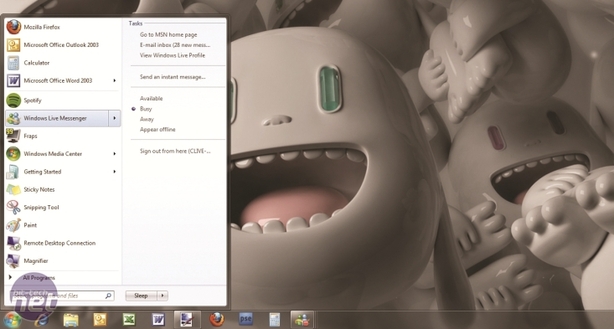
Upgrading from Windows XP
The decision to upgrade should be fairly straightforward for Windows XP users, as Microsoft has announced that it has stopped supporting Windows XP, so bug fixes and improvements are off the menu. Security updates will still continue to be rolled out until 2014, though. Hardware vendors are also releasing driver updates less frequently, so it could be that sticking with XP actually limits your upgrade potential in the next few years.Upgrading from Windows XP to 7 brings quite a few changes, although not all are for the better in some people’s eyes. For example, folder navigation may be a little confusing at first because, as with Vista, there is no button to go up one level in your folder structure. Instead, you click on the folders in the address bar, which follow Vista’s breadcrumb approach. This can be a little confusing at first, but it’s great for navigating quickly through large folder structures.
As we've discussed, the user interface of 7 is a lot more intuitive, thanks to the improvements Microsoft has made to the taskbar. This acts like a combination of XP’s Quick Launch and taskbar areas. You can pin often-used applications to Windows 7’s taskbar so that they’re always at hand, while any other application running will sit next to these large, pretty icons and look exactly the same. This may sound confusing, but it’s actually brilliant.
Finding a specific application window is easier too, as they’re now stacked more effectively on the application icon in the taskbar. Hovering over the application icon brings up a live preview of the windows you have open, enabling you to select the one you need. Even better, right-clicking on an application icon in the taskbar brings up a list of recent instances of that application, so right-clicking on Word brings up a list of recent documents. You can also pin often-used files to this list, so if you frequently check the same spreadsheet or Word file, you can pin it there for quick access without cluttering your desktop with shortcuts or having to browse through folders.
Windows Desktop Search is another major improvement over what XP offers, as it enables you to find documents and files quickly by typing into the Start menu. The search is based not just on filenames, but also, in the case of text-based documents, their contents. You can even launch applications using Desktop Search instead of trying to find the right shortcut in the Start menu – just hit the Windows key, type the first letters of the application until Windows has found the right one, and then hit Enter.

Don't forget to phone mum!
This feature was first introduced in Vista, but has been refined and improved for Windows 7. We also like the way you can quickly launch recent instances of an application from the shortcut in the Start menu. Follow the little arrow next to the Word entry, and you’ll see the same list you’d see if you right-clicked the icon in the taskbar, complete with your pinned documents. You can even change your MSN status via its entry in the Start menu.
Media Center now includes native support for AVCHD video, which means you can now play more high-definition content without the need for third-party codecs. This has enabled Microsoft to add native support for GPU-accelerated decoding. Video transcoding to portable media players is now a simple drag and drop, although iPods and Zunes aren’t supported yet.
Gamers have a compelling reason to upgrade to Windows 7, as XP won’t be updated beyond DirectX 9. At some point, game developers will stop writing a DirectX 9 code path and DirectX 10 will become the minimum specification – the first such game is expected later this year. Thankfully, now that games are being designed from scratch with DX10 in mind, we’re starting to see them deliver on the promise of improved visuals and higher frame rates – Far Cry 2 runs faster in DX10 mode than in DX9, for example.
Windows 7 introduces the newest version of DirectX, DirectX 11, which brings some significant updates to the table. The biggest change is DirectCompute, which lets software developers run any kind of instruction through a GPU. We discuss this further in our DirectX 11 feature from last year. DX11 will be released for Vista too, but there’s no chance of seeing it on XP.

MSI MPG Velox 100R Chassis Review
October 14 2021 | 15:04









Want to comment? Please log in.